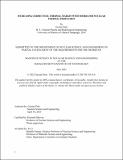Increasing Cermet Fuel Thermal Margin with Thoria for Nuclear Thermal Propulsion
Author(s)
Park, Gyutae
DownloadThesis PDF (6.506Mb)
Advisor
Shirvan, Koroush
Terms of use
Metadata
Show full item recordAbstract
Nuclear thermal propulsion (NTP) technology was identified as an alternative for faster space travel over chemical combustion propulsion systems by NASA in its Design Reference Addendum 5.0. Potential improvements to NTP performance were considered by improving the fuel margin to melting point. A thorium-dioxide stabilized, high-assay low enriched uranium (HALEU) tungsten-uranium dioxide (W-UO2) CERMET fueled nuclear thermal propulsion (NTP) concept was produced based on the Space Capable Cryogenic Thermal Engine (SCCTE) reactor1.
Axial fuel thoria fraction adjustments to improve the fuel thermal margin the reactor’s specific impulse were studied using a one-dimensional axial thermohydraulic analysis of an equivalent annulus model of the average fuel coolant channel. Based on the one-dimensional analysis, fuel composition was adjusted leading to a fuel mass decrease of 5.45 kilograms, excess-reactivity reduction of 962 pcm, and an increased fuel margin to melting point of 740 K for the average fuel.
Finally, a three-dimensional computational fluid dynamics (CFD) model of the hottest fuel pin of the base and adjusted designs with neutronics-informed three-dimensional fuel heating rates were compared. The CFD analysis predicted fuel melting in the hottest pin of both designs, identifying the potential need for additional design adjustment outside of fuel composition. The suggested changes reduced the total melting volume by 10 percent. Thus, temperature-informed adjustment of fuel thoria fraction offered improvements in fuel melting point.
Date issued
2023-06Department
Massachusetts Institute of Technology. Department of Nuclear Science and EngineeringPublisher
Massachusetts Institute of Technology